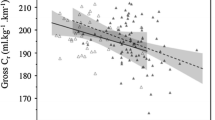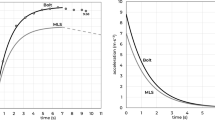Abstract
The effect of age and body size on the total mechanical power output (Ẇtot) during running was studied in children of 3–12 years of age and in adults. Ẇtot was measured as the sum of the power required to move the body's centre-of-mass relative to the surroundings (the "external power", Ẇext) plus the power required to move the limbs relative to the body's centre-of-mass (the "internal power", Ẇint). At low and intermediate speeds (less than about 13 km h–1) the higher step frequency used by young children resulted in a decrease of up to 40–50% in the mass-specific external power and an equal increase in the mass-specific internal power relative to adults. Due to this crossed effect, the mass-specific Ẇtot is nearly independent of age. At high speeds the mass-specific Ẇtot is 20–30% larger in young children than in adults, due to a greater forward deceleration of the centre-of-mass at each step. The efficiency of positive work production, calculated as the positive mechanical power divided by the net energy consumption rate, appears to be similar in children and adults (i.e. 0.40–0.55).
Similar content being viewed by others
Author information
Authors and Affiliations
Additional information
Received after revision: 27 November 2000
Electronic Publication
Rights and permissions
About this article
Cite this article
Schepens, B., Willems, P., Cavagna, G. et al. Mechanical power and efficiency in running children. Pflügers Arch - Eur J Physiol 442, 107–116 (2001). https://doi.org/10.1007/s004240000511
Received:
Accepted:
Published:
Issue Date:
DOI: https://doi.org/10.1007/s004240000511




